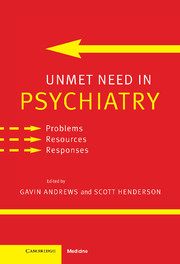Book contents
- Frontmatter
- Contents
- List of Contributors
- Preface
- Part I Unmet need: defining the problem
- Part II Unmet need: general problems and solutions
- Introduction
- 4 The epidemiology of mental disorder treatment need: community estimates of ‘medical necessity’
- 5 Some considerations in making resource allocation decisions for the treatment of psychiatric disorders
- 6 The need for psychiatric treatment in the general population
- 7 Comparing data on mental health service use between countries
- 8 The challenges of meeting the unmet need for treatment: economic perspectives
- 9 Unmet need for prevention
- 10 Meeting unmet needs: can evidence-based approaches help?
- 11 Unmet need for management of mental disorders in primary care
- 12 Is complementary medicine filling needs that could be met by orthodox medicine?
- Part III Unmet need: people with specific disorders
- Part IV Unmet need: specific issues
- Part V Unmet need: conclusion
- Index
4 - The epidemiology of mental disorder treatment need: community estimates of ‘medical necessity’
from Part II - Unmet need: general problems and solutions
Published online by Cambridge University Press: 21 August 2009
- Frontmatter
- Contents
- List of Contributors
- Preface
- Part I Unmet need: defining the problem
- Part II Unmet need: general problems and solutions
- Introduction
- 4 The epidemiology of mental disorder treatment need: community estimates of ‘medical necessity’
- 5 Some considerations in making resource allocation decisions for the treatment of psychiatric disorders
- 6 The need for psychiatric treatment in the general population
- 7 Comparing data on mental health service use between countries
- 8 The challenges of meeting the unmet need for treatment: economic perspectives
- 9 Unmet need for prevention
- 10 Meeting unmet needs: can evidence-based approaches help?
- 11 Unmet need for management of mental disorders in primary care
- 12 Is complementary medicine filling needs that could be met by orthodox medicine?
- Part III Unmet need: people with specific disorders
- Part IV Unmet need: specific issues
- Part V Unmet need: conclusion
- Index
Summary
A 50-year historical perspective is provided on US attempts to define and quantify the need for mental health services. Early epidemiological estimates of mental disorder prevalence were so far in excess of available treatment capacity that they supported initiation of major National Institute of Mental Health (NIMH) training programs to produce mental health specialists and to increase the supply of service center resources. Despite the increased treatment capacity demonstrated by the early 1980s, the Epidemiologic Catchment Area (ECA) study (Robins & Regier, 1991) indicated that of the 28% of the population that met annual diagnostic criteria for a mental or addictive disorder, over two-thirds received no treatment during the year – similar rates were demonstrated by the National Comorbidity Survey (NCS) in the 1990s (Kessler et al., 1994).
However, the 1990s brought a major change in the delivery of US mental health services. Managed behavioral health care resulted in marked decreases in definitions of need for inpatient mental health care, and greatly limited the indications of ‘medical necessity’ for outpatient treatment. Legislators have accelerated efforts to prioritize treatment need by specifying severe disorders (2.8% of the population) considered most in need of treatment and insurance coverage. Hence, the objectives of an epidemiological survey sensitive to the needs of patients, providers, managed care company guidelines, and policy planners in this context include the following: generate prevalence rates of disorders by disability levels; match these rates with need for specific treatment procedures; identify the unit and aggregate costs of treatment needed for the population in each category; and link such service costs to the benefits which would accrue for the health, social welfare, and productivity/economy of the population.
Keywords
- Type
- Chapter
- Information
- Unmet Need in PsychiatryProblems, Resources, Responses, pp. 41 - 58Publisher: Cambridge University PressPrint publication year: 2000
- 9
- Cited by



